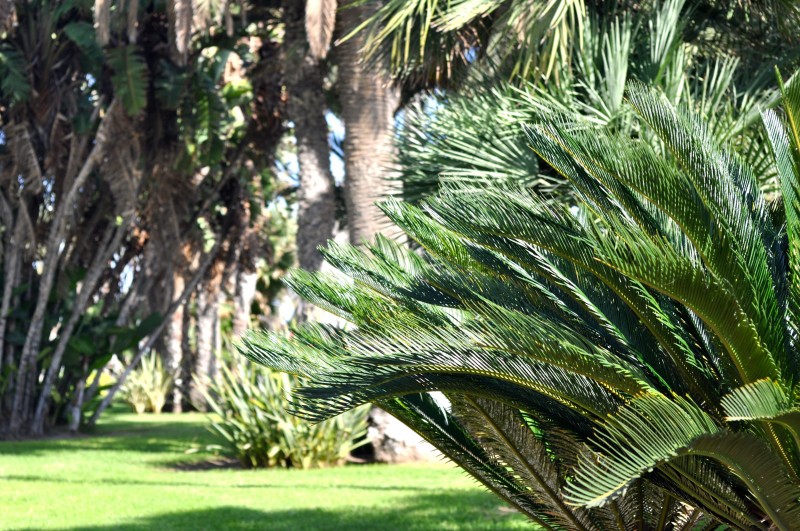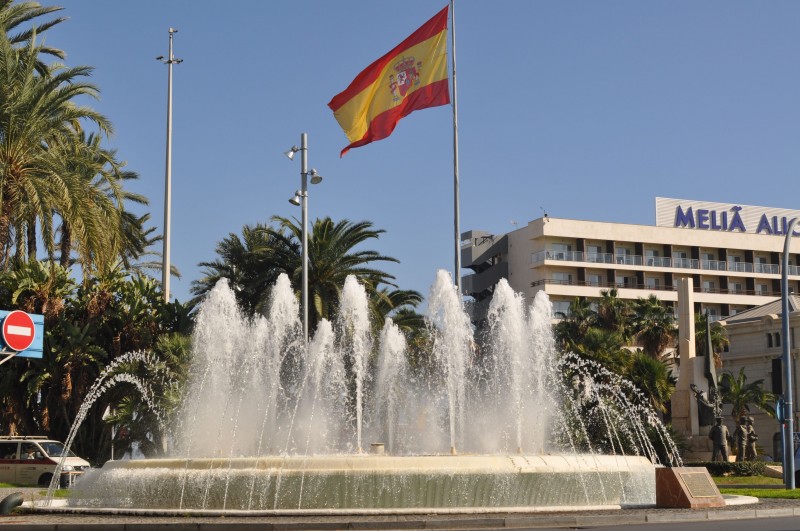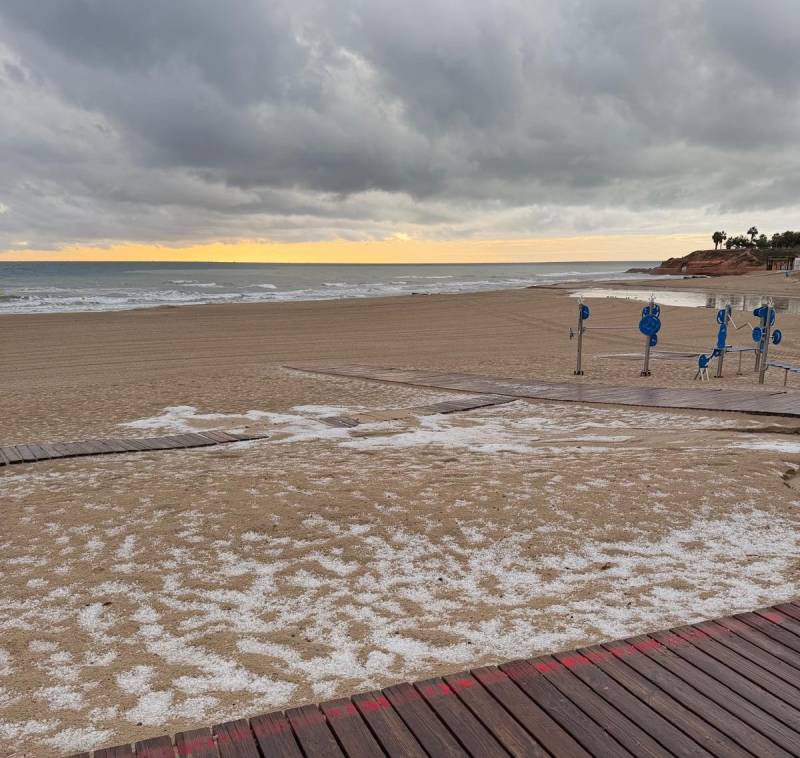- Region
- Vega baja
- Marina Alta
- Marina Baixa
- Alicante
- Baix Vinalopo
- Alto & Mitja Vinalopo
-
ALL TOWNS
- ALICANTE TOWNS
- Albatera
- Alfaz Del Pi
- Alicante City
- Alcoy
- Almoradi
- Benitatxell
- Bigastro
- Benferri
- Benidorm
- Calosa de Segura
- Calpe
- Catral
- Costa Blanca
- Cox
- Daya Vieja
- Denia
- Elche
- Elda
- Granja de Rocamora
- Guardamar del Segura
- Jacarilla
- Los Montesinos
- Orihuela
- Pedreguer
- Pilar de Horadada
- Playa Flamenca
- Quesada
- Rafal
- Redovan
- Rojales
- San Isidro
- Torrevieja
- Comunidad Valenciana
Plaza Puerta del Mar in Alicante City
An important landmark connecting Postiguet beach with the city port and the Explanada de España

The Puerta del Mar is a central plaza in the city of Alicante, formed by two large green islands. It is situated between the Paseo de la Explanada de España, Alicante’s famous maritime promenade, and Paseo de Gomiz, the promenade running parallel to the playa de Postiguet, Alicante’s city beach. The plaza splits the main roads of Avenida Conde de Vallellano and Juan Bautista Lafora, dividing the traffic into two lanes as cars approach the city port, with one of the lanes joining onto Calle Muelle de Levante, the road running alongside the port leading to the cruise ship terminal.
Being such a short distance away from the cruise ship port, the beach, the Explanada and the Plaza del Ayuntamiento, the plaza is frequently used as a landmark when giving directions to some of the main places of interest in the city centre, as well as a convenient meeting point for groups of friends or guided tours.
In the early sixteenth century during the reign of Charles V the city of Alicante was equipped with modern fortifications to replace the ruins of the fortified walls constructed during the Medieval period which replaced those built when the Moors occupied the city.
In 1544 the Duke of Calabria therefore reconstructed the Puerta de Mar, which was one of the entrances and existing gates joining onto the fortified walls that previously bordered the city for protection. The gateways were then destroyed along with the fortified walls during the second half of the 19th century, and the area of the Puerta del Mar was transformed into the plaza that we see today, which now takes the name of the pre-existing gate.

The plaza is formed by two large islands of grass and plants, breaking up the traffic from the Avenidas of Conde de Vallellano and Juan Bautista Lafora. The larger or the two islands, the nearest one to Posiguet beach, composes of a garden of colourful flowers and several palm tress. This little island is also home to the monument of the Soldado de Reemplazo, (replacement soldier) which was erected by the Minister of Defense, Federico Trillo, in 2001. The monument represents and honours all of the young men who were forced to go to war and fight during the Spanish Civil War (between 1936 and 1939).
However, as well known as it might be, there was some controversy surrounding this monumental statue. In 2015 proposals were made by Alicante representatives of Compromís (the Valencian Commitment Coalition) to remove the monument and transfer it to the military base in the barrio of Rebasa in Alicante. This was because they considered the monument to be too militaristic, holding values which no longer relate to our current 'peaceful' society. They also highlighted that although the monument honoured young men, the majority of them were forced to go to war despite many being conscientious objectors.
There were suggestions to remove the monument and construct a tourist office in the area, as part of a new urban plan to reform the space between the Explanada de España, and the Playa de Postiguet, Alicante’s city beach. However the proposals have not yet been met, due to the great cost of the project, which the Mayor of Alicante calculated at around 550,000 euros, as well as the fact that the monument, for many citizens of Alicante, is not directly associated with nationalism, but is rather viewed as a tribute to the young soldiers who lost their lives.
The smaller island, closer to the Plaza del Ayuntamiento, has a huge ornamental fountain in the middle, which was installed in 1959. The fountain is a particularly attractive feature at night -time when the jets of water light up in different colours, a marvellous display which can be seen and enjoyed even from as far as the top of the Explanada de España.

Plaza Puerta del Mar is further decorated by a large floral escudo, the coat of arms of Alicante City formed from plants, hedging and seasonal flowers which stands out as visitors enter the city.
The plaza is designed as a place for relaxation and respite from the summer heat, so as well as the cooling waters of the fountain, benches are also provided throughout, lending welcome shade beneath the lush palm trees and vegetation.
Backing onto the plaza on the side of the Plaza del Ayuntamiento, there are two important and emblematic buildings. The nearest building is the large, white, rectangular building with a flat roof and arched doors. Originally this building was the old Palace of Conde Soto, built in the second half of the 19th century. It was then converted into a prestigious hotel called Hotel Palas (Palace) before the Chamber of Commerce acquired the building in 2006 and converted it into their headquarters.
Next to this building, joining onto the Explanada de España, is the beautiful Casa Carbonell, a residential construction dating back to 1925 and designed by the famous architect, Juan Vidal Ramos. This building is by far one of the most emblematic buildings in the whole of Alicante city, with its elegant, historicist architecture, standing out from the rest of the more modern, urban constructions in the city centre. The building has four levels, each with rows of tiny windows, and is topped with four towers with pale blue circular domes.
The Plaza Puerta del Mar also serves as the main crossing zone for many bus lines.
Bus lines
Line 21 and 21 N to Playa de San Juan
Line 22 to Cabo La Huerta
Line 23 N To San Juan y Mutxamel
Line 24 N to San Vicente
Line C-6 to the Alicante-Elche Airport
Click for more information about Alicante City, including what to see, what’s on and useful local information


































